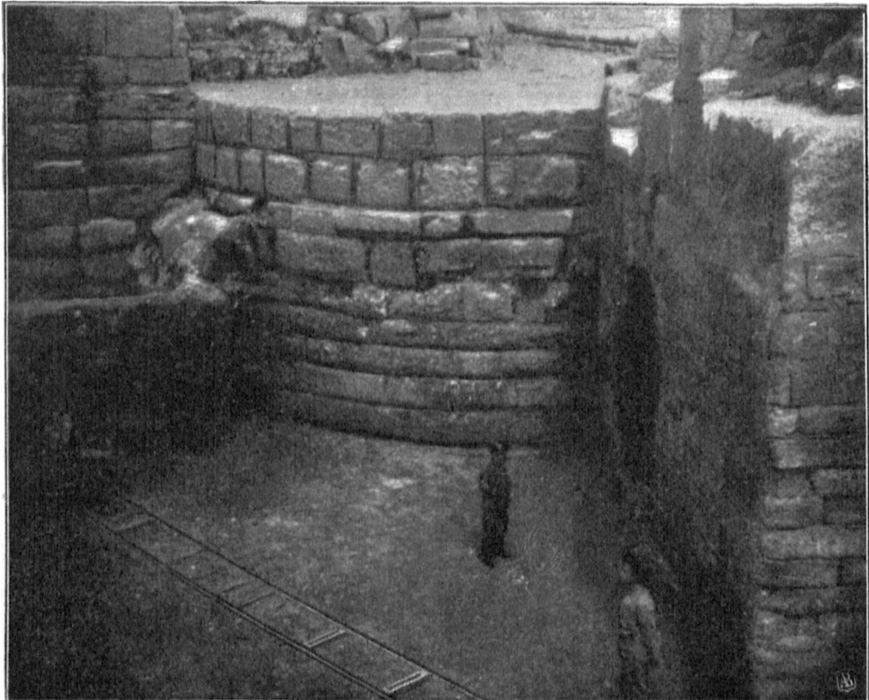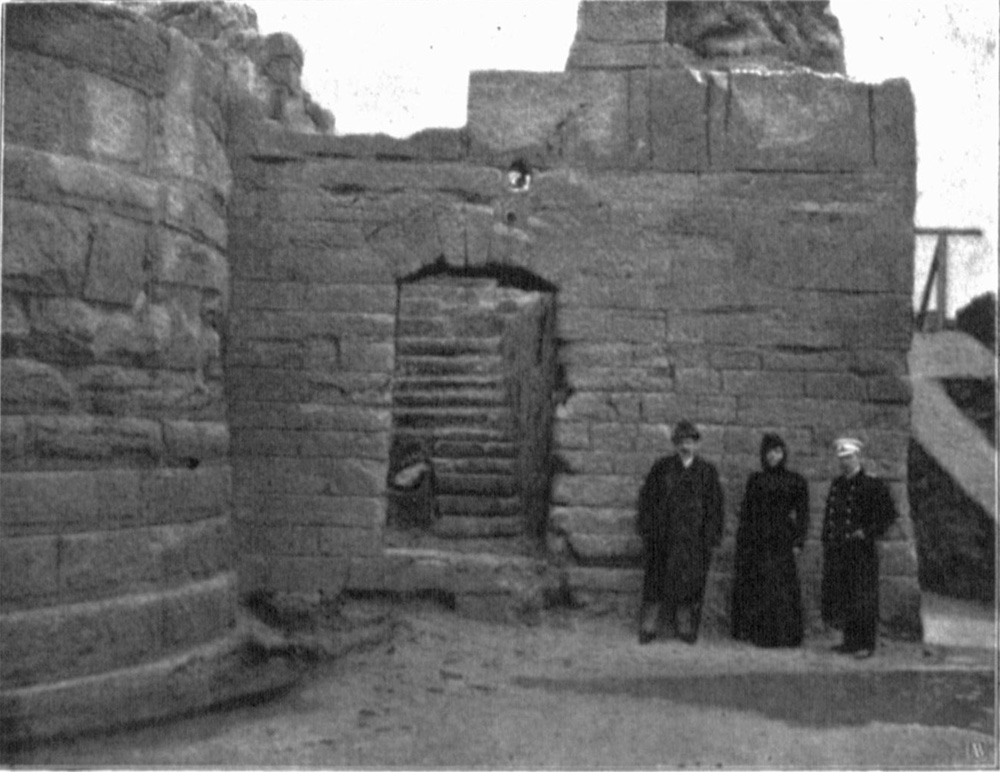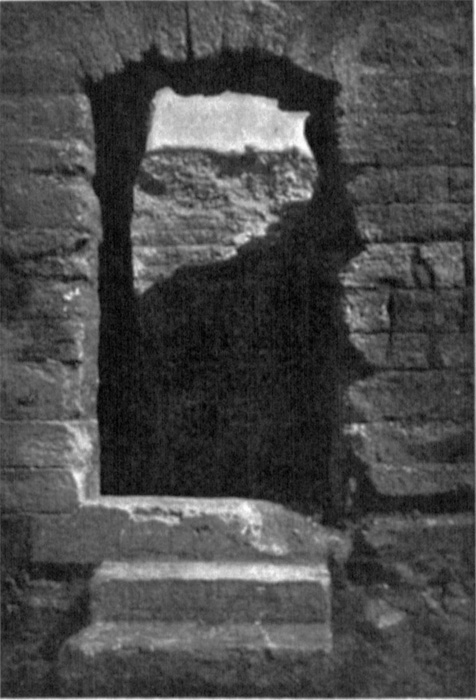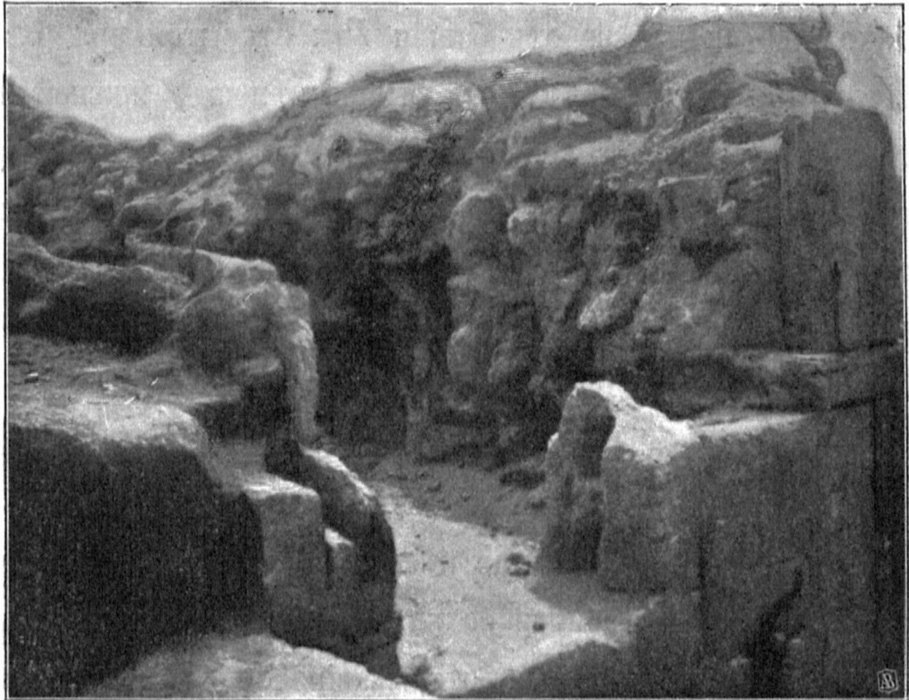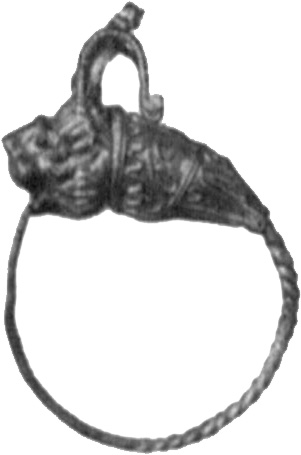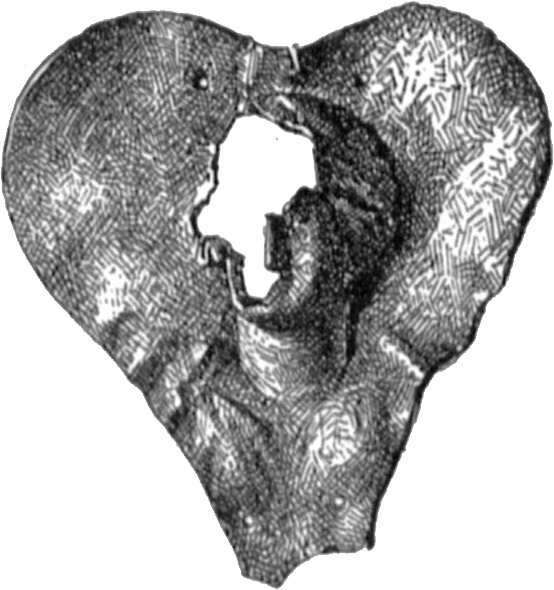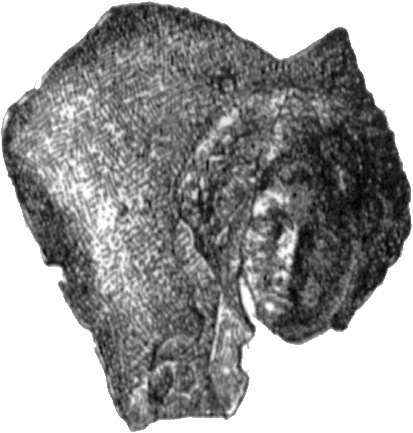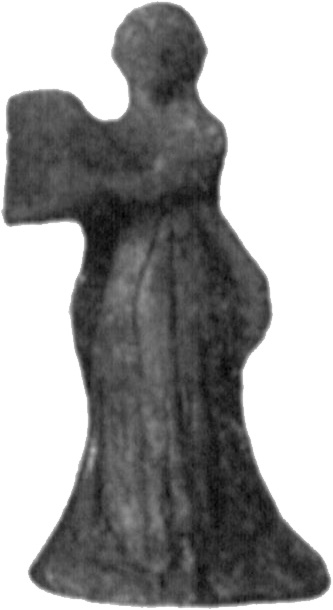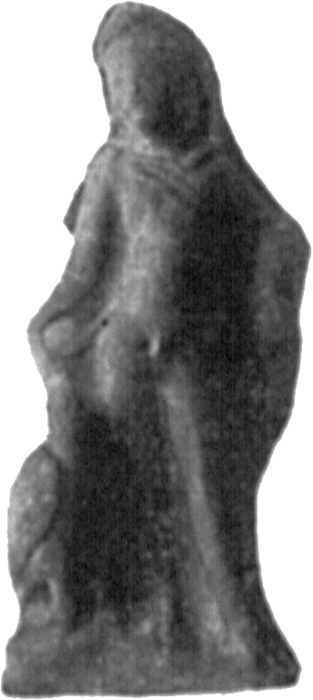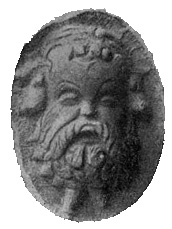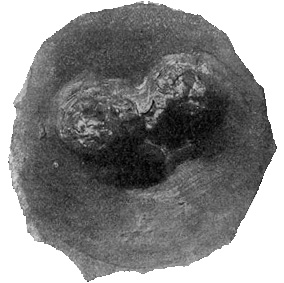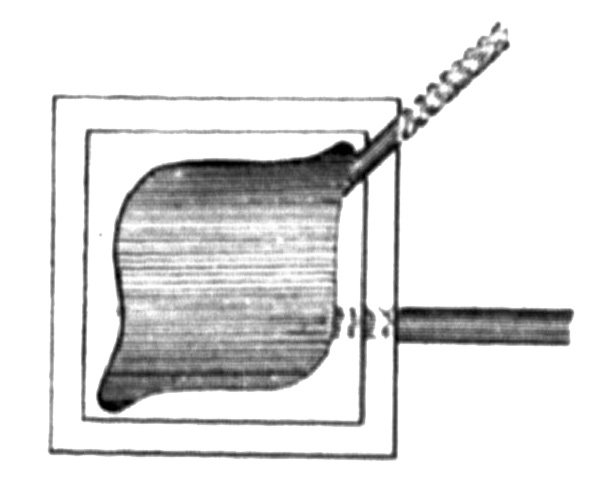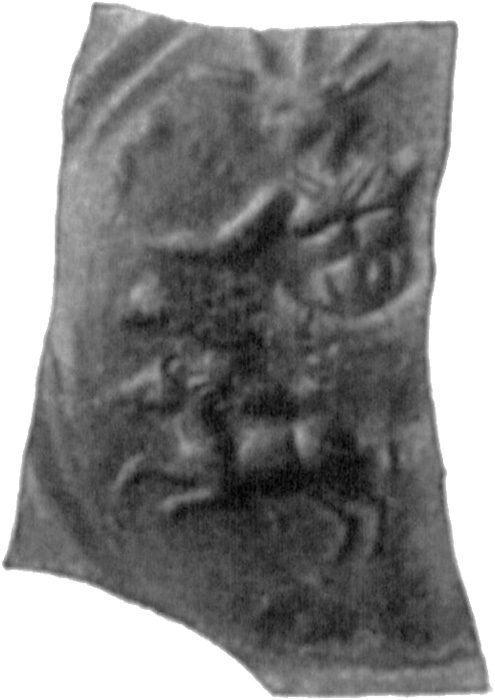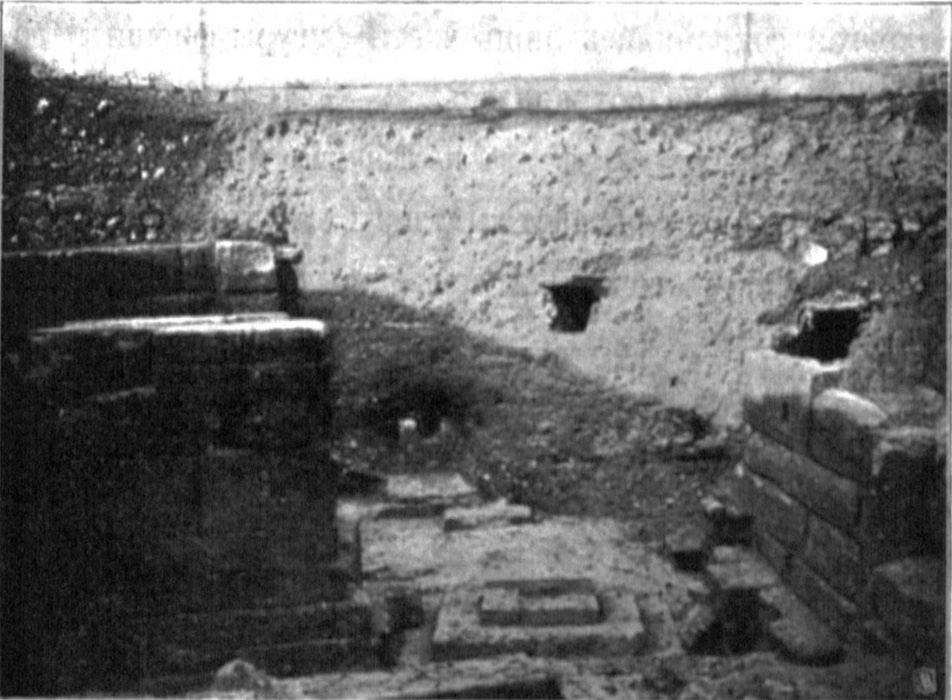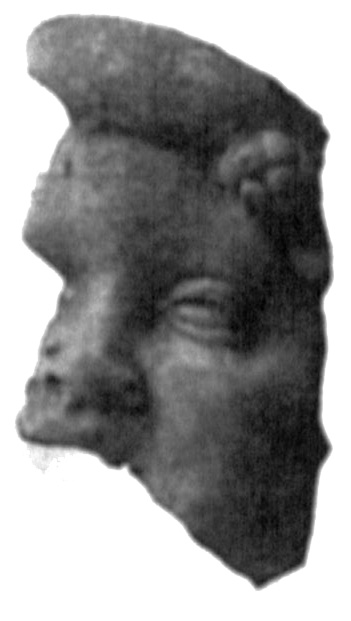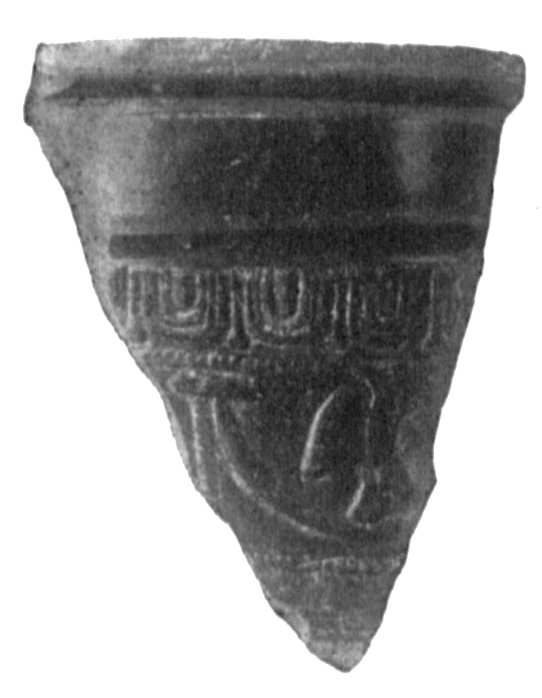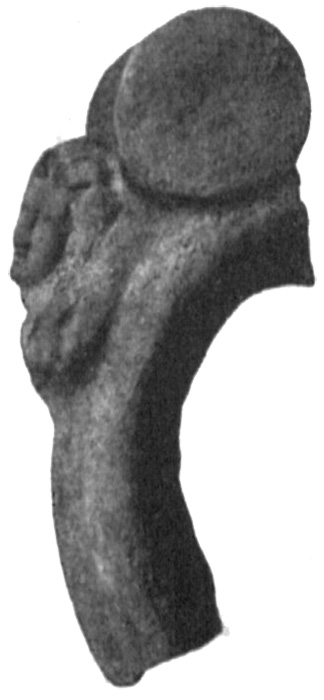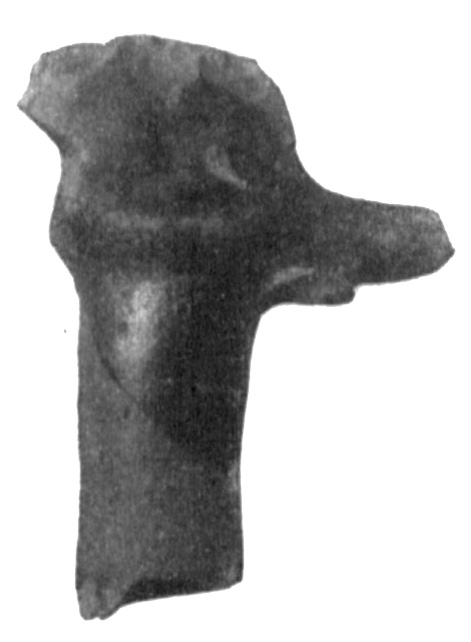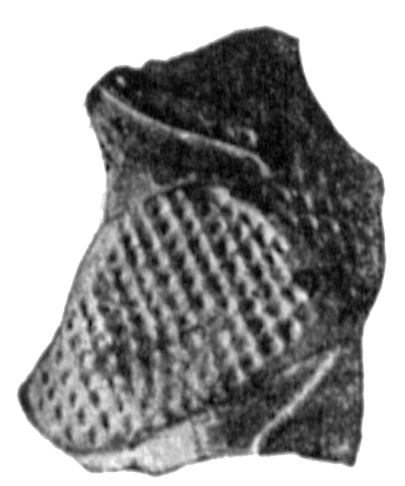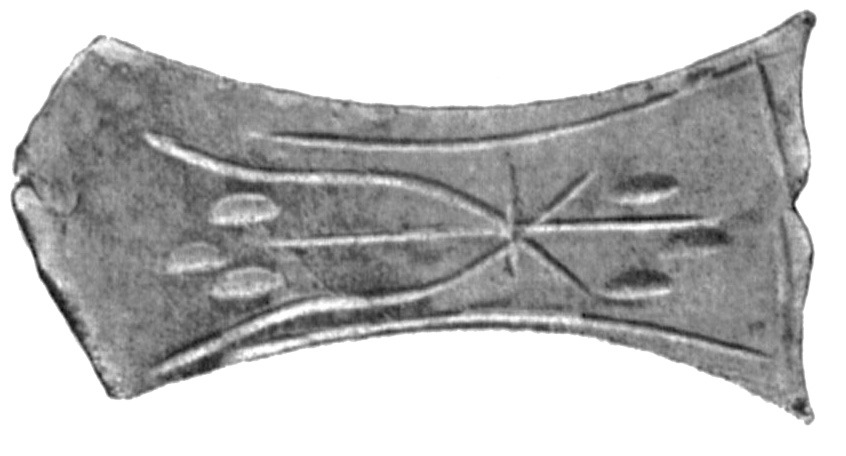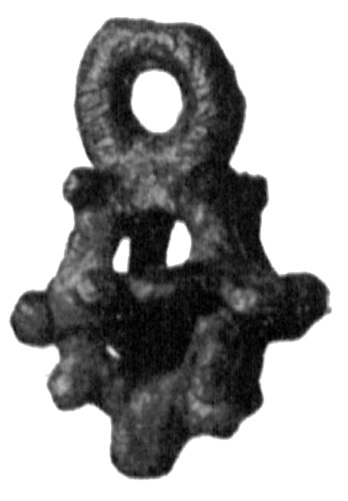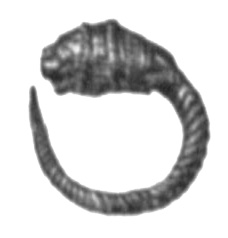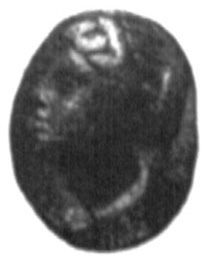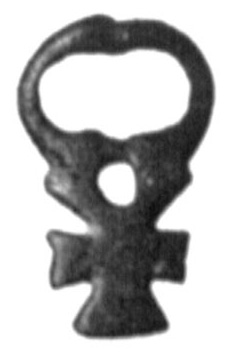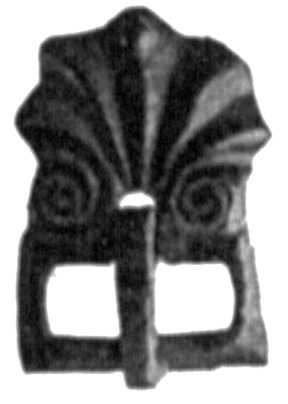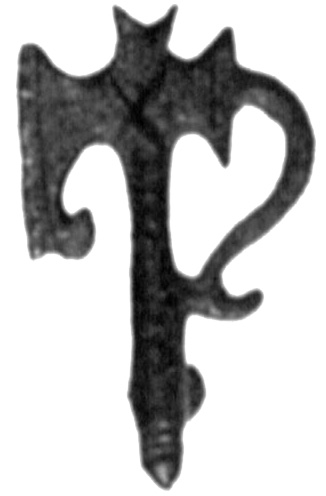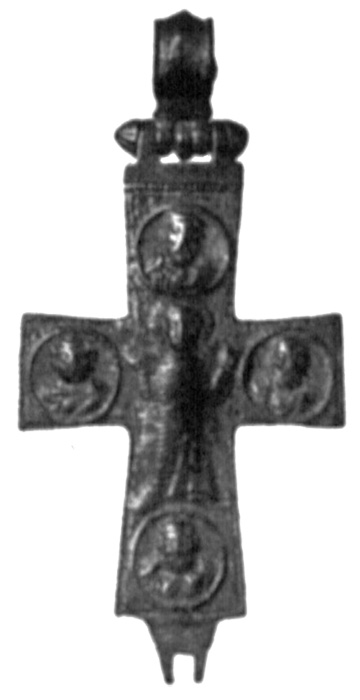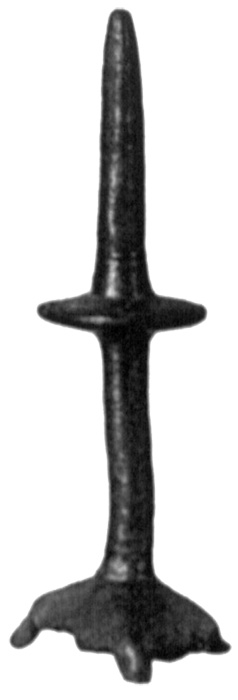1900 REPORT OF THE HEAD OF THE EXCAVATIONS IN CHERSONESOS MR K. K. KOSTSYUSHKO-VALYUZHINICH
I. Excavations in Chersonesos
In Chersonesos, the correspondent member of the Commission K.K.Kostsyushko-Valyuzhinich continued the excavations, which had been started in 1888
[1]
.
In the year under report, the works concentrated mainly at the outer side of the city wall, from the passage to military wharf and the warehouse of antiquities to the big flanking tower, which was discovered in 1898. When deepening down to the bedrock at the right from the breach, which is used for driving to the warehouse of antiquities, collapsed kiln for baking lime has been discovered in a layer of the Byzantine period. The bedrock at the part of the wall to the right from the breach is the same ascent to the city gate, as that to the left from the breach. 14.20 m far from the breach, city wall A is set against tower Г (see plan in Pl. I), which is 10.20 m in diameter and remains 4.70 high above the bay level. This tower is constructed of rusticated slabs; according to the masonry and the fact that it was under walls of the Roman period, it had been probably constructed simultaneously with the wall, which was located to the left from it, and belonged to the fourth century BC, the same as the wall uncovered under 1899 excavations. It is possible that tower Г
(Fig. 27)
originally was the extreme southern point of the city.
In the course of time, when the city enlarged, new flanking tower E was constructed (it was uncovered in 1898) and connected with the ancient tower Г. The wall connecting these two towers (85.77 m l) is a zigzag line: it goes back from tower Г to point б (5.68 m far) and from this place only it goes straight to tower E. There is a postern in wall Гб (2.40 m h and 1.46 m w), which runs through the wall as a vaulted tunnel 3.20 m long
(Fig. 28
and
29
[2]
).
Wall А is not connected with tower Г as the wall located to the left from the tower does, but is only built closely to it. This wall (А) is laid of plain slabs that were not trimmed as rustic work. One can establish its date due to the amphora handles bearing names of astynomoi of Chersonesos, which have been found there in great number: the wall should be dated to the third or second century BC. When the wall of the Greek period was, by some reason, covered with soil in the Roman period, tower Г and the above-mentioned postern were covered also. It was then that new postern a (1.78 m wide) was constructed above it; lower masonry line and threshold remained of the new postern
(Fig. 30)
.
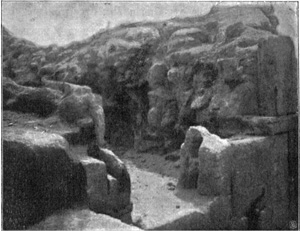
|
| Fig. 30 |
In order to enter the city via the lower postern, one needed to go round the corner б of the buried ancient wall, which is why it was greatly worn off. There obviously was much traffic through the postern at tower Г. In the wall above the vault of lower postern, there were clay water pipe ж and (higher) water channel e, both constructed when the lower postern was already covered. Among the slabs covering channel e, two appeared to be ancient gravestones; one of them was decorated with a relief image of a man and supplied with an inscription
[3]
.
The wall that connects towers Е and Г is only traceable as long as the corner of wall В, which was constructed at the same time with the 2nd ring of tower Е; it is 1.06 m wide and is constructed of hewn slabs laid with lime above bedrock, which visibly rises here. Wall В strengthens wall А; this wall, the second ring of tower Е, gate to the right from that tower, and the whole wall Б were undoubtedly (among the other arguments, it comes from one stone in the second ring of tower E with cross carved into it) constructed in the Byzantine period to reinforce defensive structures in the city at place, which obviously had great strategic importance. The postern to the left from tower Е was built in the Roman period when ancient Greek constructions were buried. Erected in the Roman period constructions continued to exist in the Byzantine period as well, which fact, apart from the buildings themselves, is evident from well-known inscriptions of the time of emperors Zeno and Isaac Komnenos. The masonry of wall А between tower Г and wall В is similar to the masonry of the wall, which is located to the left from tower Г and was discovered in 1899 excavations. Intermediate course, 1.06 m high, between the lower (Greek) part of the wall and upper (Roman) one, is carelessly laid of different slabs and certainly was the foundation of the Roman wall. The fact that the course of irregular masonry completely coincides with both the direction of the lower wall and its broken outer side does not contradict significantly to the above explanation of this course. Such a use of ancient foundations was usual in the Roman period
[4]
.
Byzantine wall Б makes a slight turn to the right, opposite to corner б of the ancient wall; at the point в, where draining channel of slabs, 0.54 m wide, goes through it, the wall turns more to the right till postern д which is 1.78 m wide; at this postern, there is stone threshold which remained in situ and had circular cut for impost of the door that opened inside and was locked with a bar, for which there were rectangular cuts arranged in the wall on either side of the postern. Under wall б, there was a part of the foundation of a house built in more ancient period. It consists of three rooms and was possibly used for a kind of workshop; its foundation is laid of stones hewn to each other and mortared with clay. One can imagine this house’s dimensions by its plan. Behind postern д, wall Б makes right angle turn to the right angle and then goes to its extreme southern point, which makes the corner of the gate of the Byzantine period. On the other side of this gate, wall Б goes around tower Е, 1.40 m far from its Byzantine ring Ж. This wall goes round the tower and then descends to the bay.
A small plot of the second century BC ancient Greek necropolis was discovered in result of the excavations behind postern д, under wall Б and on both sides of it; the most part of the tombs was destroyed when building wall Б. The excavations of the area located at the outer side of this wall discovered that the burials occupied only the site shown on the plan and did not stretch farther.
When Byzantine layer was removed from the area in between of the walls Б and В, stone fence of irregular form, laid strongly with lime mortar, was discovered behind postern д. Within this fence, there were scattered slabs of destroyed tombs of the late Roman period, fragment of iron sword, different earthenware vessels, various earrings, wooden handle of knife with bronze head and rivets, and coins of emperors Maximinos II, Constantine the Great, and Constantius II. When deepening the trench down to bedrock, 23 burials in tombs nos. 1015-1037 have been discovered
[5]
.
These burials and tombs were of different forms. The tombs were constructed of either stone slabs (nos. 1017, 1026, 1034) or roof tiles (nos. 1029-1032, 1037); the tombs constructed of stone slabs were sometimes faced with roof tiles inside (nos. 1016, 1019, 1020). Cremation with bones put into earthenware urns was not a rare case. The urns were usually (except for no. 1015) placed into tombs of stone slabs (nos. 1018, 1022, 1023-1025, 1027, 1035, and 1036). Inhumation and cremations are sometimes found in the same tomb: urns with fired bones have been uncovered in two stone tombs containing inhumations (nos. 1021, 1033). Tomb no. 1020 was a cist of stone slabs aimed for an urn with bones, which, however, was not placed into it. These tombs contained the following artifacts: different gold earrings, the most interesting of which were found in tomb no. 1016
(Fig. 31)
, different gold wreathes and plates, fragments of gold necklaces (one of which is chased), bron finger-rings, mirrors, key, hair pins, 2 silver badges carved in the form of hearts with relief busts
(Fig. 32
and
33)
silver buckles, various terracotta statuettes
(Fig. 34,
35,
36,
37)
, glass and paste pendants and beads, scarab of paste with hieroglyphs, interesting lead votive symbols with images of Hermes’s head on one side and bull’s skull decorated with garland on the other, various pottery.

|

|

|

|
| Fig. 34 |
Fig. 35 |
Fig. 36 |
Fig. 37 |
No doubts, these burials are of earlier period than the neighboring remains of buildings, kilns for baking pottery and terracottas, which are carved in bedrock, pits for preparing clay, pools, wells, etc. Only one tomb (no. 1017) contained two bronze coins of Chersonesos of the Greek period (Burachkov, Sborn mater [Collected materials…], XIV.14 and 20). Here, for the first time in Chersonesos, we meet with above-mentioned lead votive symbols (tomb no. 1029), silver heart-shaped badges with reliefs
(no. 1035, see figs.
32
and
33
)
and gold hollow hemispheres in openwork and filigree, with a hole in the middle, which are on both sides decorated with chalcedonic, garnet and glass beads forming a part of necklace (no. 1016). Roof tiles, which were used for making tombs and facing slabbed graves inside, are certainly of non-Chersonesian origin; tiles of local manufacture are different with their color and quality of clay. Fragments of tiles facing tombs nos. 1019 and 1020 inside preserved two similar stamps with image of eagle on dolphin and inscription:

Emblems very rare accompany names of Chersonesian astynomoi on tiles or amphora handles. All the described tombs should probably be dated to the second century BC because of two coins uncovered from tomb no. 1017 and the great number of amphora handles with names of Chersonesian astynomoi as found nearby.
In the area to the S and to the E from the small site described above, there were: foundations of slabs mortared with clay з-з, two channels и-и and three cuts к-к-к in perpendicularly finished wall. Above it, bedrock is cut as semicircle to be used as a foundation of kiln for firing terracottas and pottery, as we can infer from the remains and from the traces of fire that survive. There were fragments of raw bricks and one intact item, different moulds for making statuettes, heads, and ornaments; among them, especially well-preserved is the mould for shaping Sylene’s head
(Fig. 38)
.

|
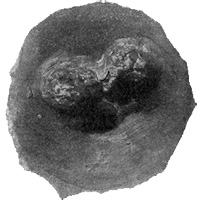
|
| Fig. 38 |
Fig. 39 |
In point н, bedrock is chopped perpendicularly, it keeps traces of fire. Higher, there is well л, turned into garbage pit, where they put fragments of broken and damaged during firing pottery. Of this pottery especially interesting is fragment of bottom of Calenian bowl with image of busts of girl and boy kissing each other, in haut relief
(Fig. 39)
1900 excavations uncovered kilns for firing clay pottery and terracottas, pits for preparing clay, wells, pools for collection and storage of water, moulds for shaping terracottas, broken amphorae with names of astynomoi on handles, and great number of brown-slip and graphite ware, which makes us to suppose that ceramic manufacture flourished in Chersonesos. No doubts, here, in Chersonesos, they produced brown-slip and graphite ware. Well л contained one of those clay stamps to impress rosettes in the bottoms of plates and saucers; this small stamp fully corresponds to the rosettes remained on bottoms of some saucers. When making pottery, craftsmen follow the examples of more valuable imported ware (with black slip).
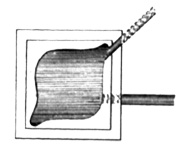
|
| Fig. 40 |
5.60 m to the right from well л, there was another well м with spring water; channel с connects it with the nearest pool for rain water р. In the Byzantine period, water was sent to the well also from the roof of big flanking tower ДЕЖ, for which purposed channel т was arranged; to pass it into the well, a cut was made in the upper slab closing this well
(Fig. 40)
The soil extracted from the well contained: simple earthenware vessel and fragments of earthenware and glass pottery, among which there were fragment of bottom of a red-slip vessel with relief image of Helios on chariot
(Fig. 41)
and fragmented top section of a small rectangular terracotta altar
(Fig. 42)
; the altar is decorated with a kind of unclear figures on top, in every corner; below the cornice, there were reliefs on each of its four sides: on the main side, we can see well-known group with Dionysus with Ariadne and Sylene
[6]
; each of the other sides had two figures: one – of a girl before trophy; on the other, only a part of figure of boy and head of the other figure survived; the fourth side did not remain.
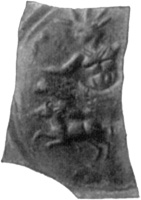
|
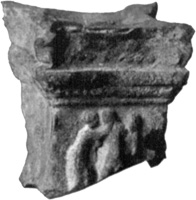
|
| Fig. 41 |
Fig. 42 |
Two rooms о and п were carved into bedrock higher than wells л and м; the first was probably intended for clay processing and the second was used as a kiln for baking amphorae. There are five circular holes carved in bedrock at the right, behind the kiln, which were intended for placing pointed-base amphorae prepared for baking. In the same area, there are 13 similar pits cut into bedrock more. There are 28 broken amphorae uncovered amidst the fragments of collapsed kiln, with the handles having imprints of the name of the same astynomos of Chersonesos Istronos son of Aopollonides.
Besides the excavations at the outer side of the city wall, К. К. Kostsyushko-Valyuzhinich continued a part of his works starting from the city gate, at the inner side of the said wall. There, under the draining channels described in 1899 report
[7]
, was a tomb laid of 15 stone slabs above the bedrock and partly sunken into
the latter
(Fig. 43)
. This tomb is rectangular, constructed as steps, and finishes with top platform composed of a single slab. In slabs of the second step, on the inner side of them, there were dovetail-shaped cuts for bondsб which probably were of wood. No artifacts were uncovered from this tomb.
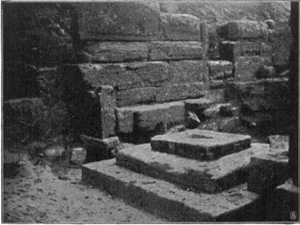
|
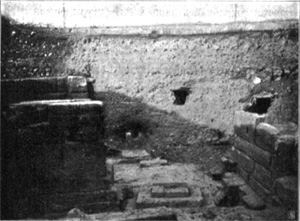
|
| Fig. 43 |
Fig. 44 |
As it can be seen at
Fig. 44
, the tomb is located lower than the foundations of the city wall and building Д at the left. It is beyond any doubt that the city gate, building Д, the wall with vault no. 1012, and the streets going from the city gate with their solid drain gutters date to the period later than the tomb described above, which may be a remnant of the necropolis of the most ancient Chersonesos. There is a part of big stone construction (which possibly was also a tomb) uncovered in front of the tomb, at the left of it; it was cut into bedrock and was hidden under the mound, on top of which monastery fence stays now.
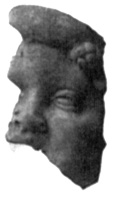
|
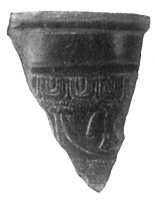
|

|

|
| Fig. 45 |
Fig. 46 |
Fig. 47a |
Fig. 47b |
Apart from the artifacts mentioned above when describing graves, firing kilns and wells л and м, the excavations in the year under report uncovered: 22 stones with Greek and Latin inscriptions
[8]
, 657 amphora handles (entire or fragmented) of different workshops, including 412 amphora handles, no doubts, of Chersonesian origin, 1 roof tile with a part of stamp, sinker with inscription, 15 shards of clay pottery with inscriptions and graffiti, 492 coins of various cities and periods, 4 fragments of marble statues, 3 fragments of terracotta statuettes, among which
there is interesting fragment of child’s head
(Fig. 45)
, 28 shards of black-slip pottery, 120 shards of brown-slip and graphite ware of local origin, 2 fragments of red-slip pottery, among which there is an interesting fragment
with image of eagle
(Fig. 46)
, 4 fragments of simple earthenware pottery with floral ornament drawn with dark-brown paint, earthenware handle of a vessel with relief female’s head
(Fig. 47a — front view, and
47b - side view)
, 4 other handles with various reliefs, 2 small narrow-neck vessels without handles, bottom of a jug, 5 fragments of vases with reliefs, covered with glaze of different colours (green, brown, white), 735 shards of earthenware glazed pottery, one-colour and with multicoloured ornaments, earthenware black-slip lamp, 3 fragments of black-slip lamps, 5 lamps of simple earthenware, 7 earthenware lamps of the Roman period with reliefs, 6 lamps without reliefs, 8 fragments of similar lamps, cock’s head of rough workmanship
(Fig. 48)
, 114 fragments of glass vessels, among which there is very interesting fragment with relief image of swimming swan
(Fig. 49)
, glass handle with carving
(Fig. 50)
, two fragments of marble mortars, 14 various tools and implements, among which a fragment of bronze key decorated with herma-shaped male bust should be noted
(Fig. 51)
,

|
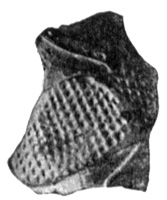
|
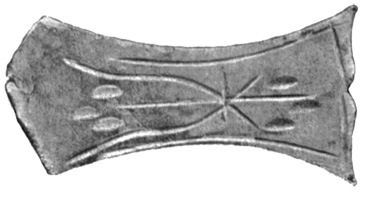
|
| Fig. 48 |
Fig. 49 |
Fig. 50 |

|

|

|
| Fig. 51 |
Fig. 52 |
Fig. 53 |
, 35 pieces of different weapons, bronze pendant for bridle in the form of knotty ball cut in openwork
(Fig. 52)
, weight mark, 256 different fishing accessories, 39 different fancywork accessories, 6 articles which were used in gaming, 37 different pieces of jewelry and accessories of costume and toilet, among which there were interesting things: massive gold earring shaped like a rope with lion’s head
(Fig. 53)
, bronze oval panel for signet-ring with woman’s head in high relief
(Fig. 54)
, bronze buckle for belt with cross carved into it
(Fig. 55)
and another one in the form of shell
(Fig. 56)
, bron halberd-shaped brooch
(Fig. 57)
; further, a half of copper reliquary cross with relief image of Mother of God with raised hands and 4 evangelists in half-figures, within medallions
(Fig. 58)
, cross of dark-grey marble, bronze candlestick with pin for candle and three feet
(Fig. 59)
, 28 different fragments from parts of houses, 8 fragments of grave monuments, one of which has semicircular cut and, above it, representations of two spears in relief, and the other has image of a hero laying on a bed, with table with food in front of it and servant boy to the right
[9]
,
, 28 different fragments from parts of houses, 8 fragments of grave monuments, one of which has semicircular cut and, above it, representations of two spears in relief, and the other has image of a hero laying on a bed, with table with food in front of it and servant boy to the right
[10]
.
|



